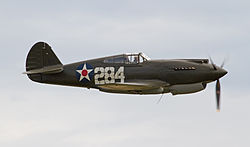Curtiss P-40 Warhawk
The Curtiss P-40 (also called the Tomahawk, Warhawk, and Kittyhawk) was a fighter aircraft that could also be used for attacking things on the ground. It was made by Curtiss. It first flew in 1938 and saw combat during World War II. It was not as fast high up as the German Luftwaffe fighters, but was used a lot in other places. It was used not only the United States Army Air Force, but also a mercenary air force called the "Flying Tigers." They put the mouth of a shark on their P-40s. It could fly to 360 miles per hour. In 1948, the United States Air Force stopped using it.
| P-40 Warhawk Tomahawk / Kittyhawk | |
|---|---|
| A restored Warhawk in the "Flying Tigers" paint scheme | |
| Role | Fighter aircraft |
| National origin | United States |
| Manufacturer | Curtiss-Wright Corporation |
| First flight | 14 October 1938[1] |
| Retired | Brazilian Air Force (1958) |
| Primary users | United States Army Air Forces Royal Air Force Royal Australian Air Force Royal Canadian Air Force |
| Produced | 1939–1944 |
| Number built | 13,738[2] |
| Unit cost | US$44,892 in 1944[3] |
| Developed from | Curtiss P-36 Hawk |
| Variants | Curtiss XP-46 |
Curtiss P-40 Warhawk Media
Curtiss XP-40 "11" used for test purposes by the Materiel Division of the US Army Air Corps
A three-quarter view of a P-40B, X-804 (s/n 39-184) in flight. This aircraft served with an advanced training unit at Luke Field, Arizona.
Evidence of the P-40's durability: in 1944 F/O T. R. Jacklin (pictured) flew this No. 75 Squadron RAAF P-40N-5 more than 200 mi (322 km) after the loss of the port aileron and 25% of its wing area, due to a mid-air collision with another P-40N-5.[N 1]
Armourers working on a Tomahawk Mk.II from No. 3 Squadron RAAF in North Africa, 23 December 1941
A Kittyhawk Mk III of No. 112 Squadron RAF, taxiing at Medenine, Tunisia, in 1943. The ground crewman on the wing is directing the pilot, whose forward view is hindered by the aircraft's nose.
North Africa, c. 1943. A P-40 "Kittybomber" of No. 450 Squadron RAAF, loaded with six 250 lb (110 kg) bombs.
3rd Squadron Hell's Angels, Flying Tigers over China, photographed in 1942 by AVG pilot Robert T. Smith.[N 2]
P-40B G-CDWH at Duxford 2011. It is the only airworthy P-40B in the world and the only survivor from the Pearl Harbor attack.
References
- ↑ Hagen, Brad. "XP-40." Curtiss P-40 Warhawk. Retrieved: 21 August 2011.
- ↑ Angelucci and Matricardi 1978, p. 48.
- ↑ "Army Air Forces Statistical Digest, World War II." Archived 2 November 2012 at the Wayback Machine United States Air Force, 2012. Retrieved: 22 October 2012.
| Wikimedia Commons has media related to Lua error in Module:Commons_link at line 62: attempt to index field 'wikibase' (a nil value).. |
Cite error: There are <ref> tags on this page, but the references will not show without a {{Reflist|group=N}} template or a <references group="N"/> tag.










